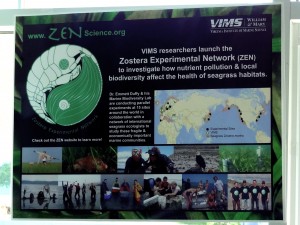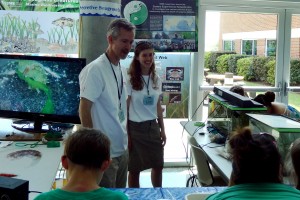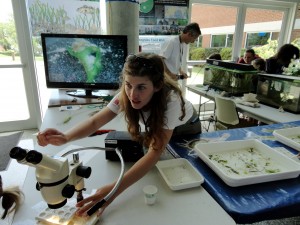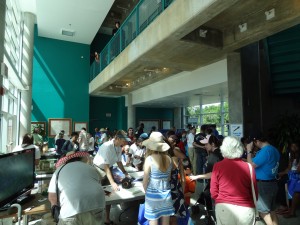ZEN at Marine Science Day 2012
by Pamela Reynolds (ZEN coordinator)
We introduced the Zostera Experimental Network to the public of Virginia at the tenth annual Marine Science Day (MSD) event at the Virginia Institute of Marine Science (VIMS) in May, 2012. Over 2,000 people visited the VIMS campus in Gloucester Point, VA for a full day of behind-the-scenes learning about marine science and the Chesapeake Bay.
Our Marine Biodiversity Lab ran an touch tank exhibit titled “Secretive Seagrass Creatures” where kids and adults had up close encounters with mesograzers and the fish, crabs and shrimp that live in local seagrass habitats. We even hooked up a high definition video camera to one of our microscopes so everyone could watch an amphipod graze on algae and make a mucus tube.
The public was very receptive and inquisitive, especially regarding the ZEN.
Questions we were frequently asked:
Q. What do you mean everyone at the different ZEN field sites did the same experiment?
A. We shipped boxes of experimental materials and sent copies of a detailed protocol (a “how to” guide book), along with instructional videos, to all of the other scientists to ensure that everyone used the same methods. The videos were great as not all of the participating students from the other countries spoke fluent English.
Q. How can you compare the Chesapeake to somewhere like Norway or Alaska? Isn’t it colder up there?
A. Yes, it most definitely is! And this variability, or differences in environmental conditions such as temperature and salinity, is very important. By having a range of environmental conditions, we have more power to understand how these factors such as being in a colder or warmer place can affect the important seagrass communities we are studying.
Q. How do you know these mesograzers are important? They’re really small. Don’t turtles, herbivorous fish and other larger marine animals eat more?
A. Although mesograzers such as amphipods are small, they can eat a lot of algae, especially the algae that grows on the leaves of seagrass and competes with the seagrass for light and nutrients. We have conducted many experiments in tanks and have found that mesograzers can do a good job at keeping the seagrass clean and promoting its growth. While turtles and fish may have larger mouths and take bigger bites of algae, they aren’t necessarily eating the same types of algae or the algae growing on the seagrass, and these larger herbivores aren’t found all over the world. Mesograzers, however, are everywhere and can be very abundant. If you grab a big handful of seagrass in the Chesapeake you can catch hundreds of amphipods!
Q. I live near the Chesapeake. Why should I care about seagrass in Japan or Sweden?
A. By studying other places we can understand how regional and global issues such as pollution, overfishing and seawater warming can threaten our local systems. Oceans make up about 70% of the Earth, and most of them are connected. If we only study the Chesapeake, we loose a valuable opportunity to help understand and predict future challenges.
Our one shortcoming from this year’s Marine Science Day – no one dressed up like an amphipod or other mesograzer for the annual Parade of Marine Life, although while cleaning up our lab we did find a child-sized Idotea (a type of marine isopod) costume from years past. Next time!






Comments are closed.